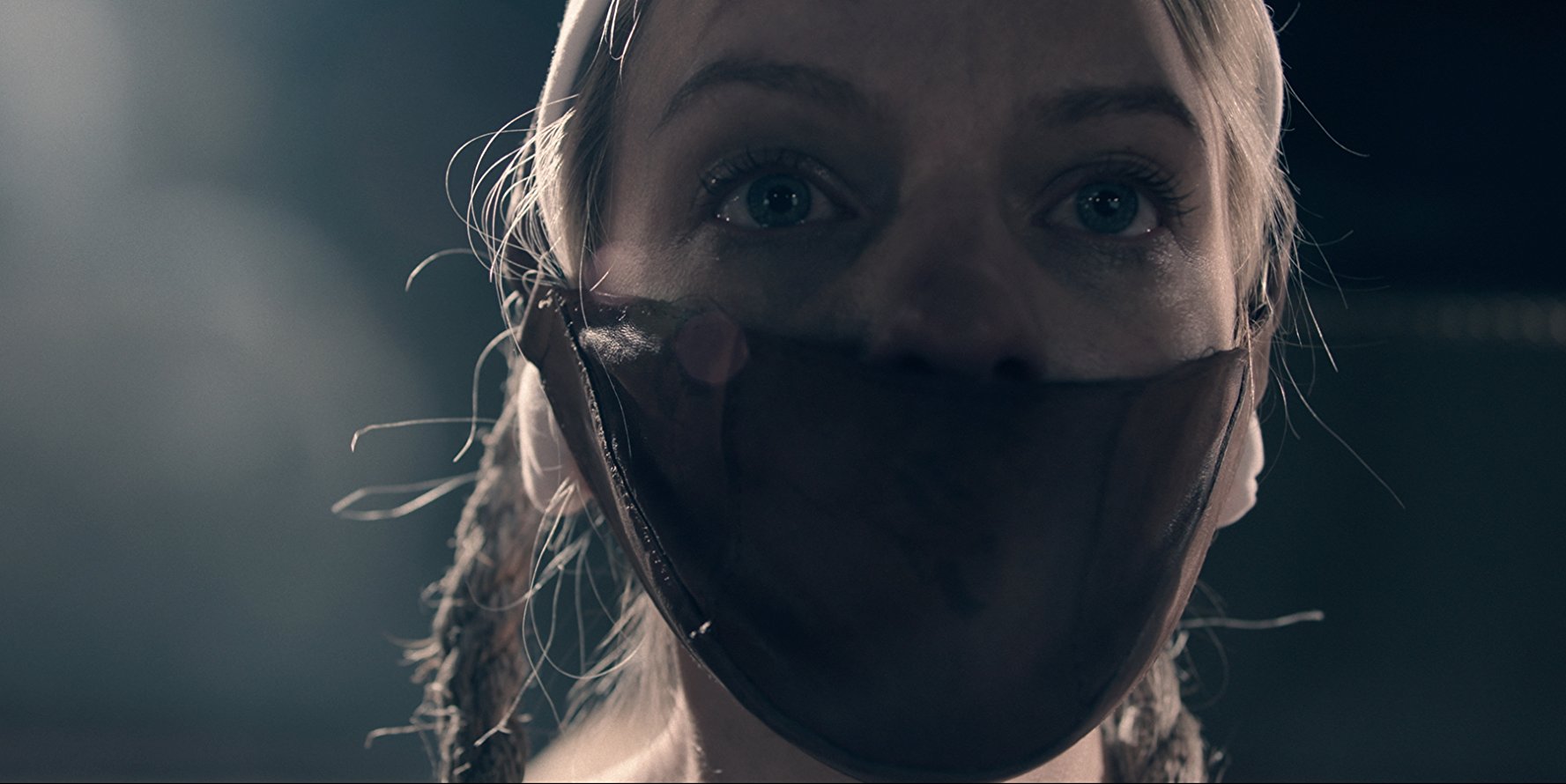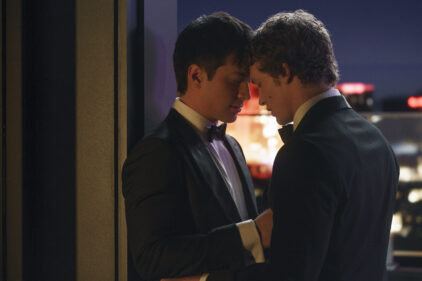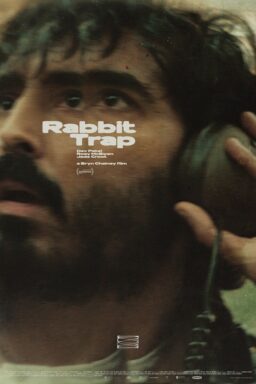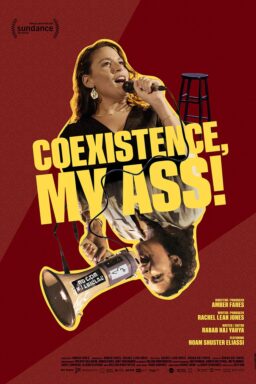The end of the first season of “The Handmaid’s Tale” features a moment of hard-won, bitterly-fought triumph: Our heroine, June, endures a mock hanging, witnesses the torture and burning of her fellow handmaids, and, in a few moments of white-knuckled nerve, finally escapes the Waterford House. She is ferried away to a safehouse, where she meets with her lover, the father of her unborn child. Finally, she can strip free of the red dress and white wimple, the sartorial symbols of her enslavement; her face twitches between rage and grief and relief as she lights a match, and watches that damn dress burn. She savagely, stoically, cuts the government tracker out of her ear; then, in a timeworn expression of womanly liberation, she hacks her hair off. “My name is June Osborne,” she says, as the flames crackle. “I’m 34 years old. I stand five-foot-three in bare feet. I weigh 120 pounds. I have viable ovaries. I’m five weeks pregnant. I am free.” It’s a grand “fuck yeah” moment in a show that traffics in “no, no, oh God, no.” It should be thrilling. Yet June’s grand declaration of freedom feels wrong, somehow—like it’s not only giving June a way out of her ordeal, it’s giving the audience a way out of truly reckoning with the real meaning and magnitude of that ordeal. “The Handmaid’s Tale” is more powerful, and more meaningful, as a study in suffering and victimization than as a tale of #Resistance.
The word “prescient” certainly got a work-out when the show first debuted just months into the presidency of Donald Trump, a man who packages Gilead-esque policies with a meat-headed machismo. The handmaid, wrenched out of her relatively autonomous life into a straightjacketed existence of constant violation, seemed the perfect avatar for those first terrified, grief-struck, and heart-sickened months in the Republic of Trumplandia. However, the show was not only prescient at articulating the thickening dread of living in the sweaty yet stiff grip of Trumpism—it also tapped into the spirit of resistance, or, should I say #TheResistance, that rose to oppose Cult 45.
The novel is quite literally a study of women’s prolonged victimization; the characters can be flinty and resilient, and while that flintiness and resilience is admirable, it is, in the end, utterly futile. Offred’s friend Moira, who escapes the handmaid training center, is re-captured and forced to work as a Jezebel, her only small comfort (if you can call it that) the oblivion of drugs and drink. Ofglen, the more hell-raising handmaid who first introduces Offred to the existence of the Mayday resistance, is disappeared by the regime. The Hulu series, by contrast, is infused with a riot grrl indignation that gives it the tinniest of silver linings—but a silver lining, a punkish hopefulness, nonetheless. Moira makes a break for the Canadian border. Ofglen lives to fight another day—she even gets a measure of vengeance: In season one, she steals an SUV and mows down her captors; in her season two, she poisons a commander’s fallen wife who has also ended up in the dreaded Colonies and strings the woman’s corpse up on a cross.

Speaking with Entertainment Weekly, Elizabeth Moss, who plays Offred, described her character as “badass and vocal and … not as good at keeping her mouth shut.” Moss promised that this newly em-badassed Offred would “[get] crushed and reborn a couple of times this season, but she also finds the strength she never knew she had and rises like a phoenix.” But turning Offred into a freedom fighter, yet another member of the phalanx of lady badasses, dilutes her story’s real power—which is not about empowerment, at least, not in the “you go girl” feel-good sense: “The Handmaid’s Tale” has resonated so deeply, and for so long, because it reminds us, with a weapon’s grade bluntness, that women can be stripped of their power, their autonomy, their identities, with a surprising quickness and ease—a finger-snap of legislation; a convoy of trucks rolling through town; or a few terrifying minutes alone with an Uber driver, a boss, a date, or even a friend. Offred’s plight was prescient for women around the world long before the orange blotivator-in-chief first descended that escalator in Trump Tower.
Of course, images of the heroine emerging victorious over her tormentors—whether that victory comes through a single well-placed punch or brilliant legal maneuvering, a flare of telekinetic fury or the choice to name and shame an abuser publicly—is a necessary corrective to so many decades spent tied to the railroad tracks, or asleep in glass coffins, or with the barrel of the bad guy’s gun pressed to her temples. The rise of the lady bad-ass on-screen—the Elevens and the Katniss Everdeens and Imperator Furiosas and the Wonder Women and the Dora Milaje—has made our storytelling more inclusive, and through that inclusivity, richer and more meaningful. But this rise coincides with a new surge of Instagram-era feminism that can simultaneously agitate for a more unilateral vision of empowerment and traffic in the easy brio of trending hashtags and memes. Sometimes, it merely feints at complexity, offering, instead a palliative, comfort food vision of reality where girls really do run the world—which, like any sweet thick sundae or bowl of extra cheesy bacon mac-and-cheese, can leave us feeling too full, too sleepy, to really move.
In 2013, Natalie Portman mused that, as a culture, we’ve taken the “strong” part of the “strong female protagonist” far too literally—that women characters were only deemed admirable if they evinced a bad-ass swagger, matching the men on-screen punch for punch. “I want [female characters] to be allowed to be weak and strong and happy and sad – human, basically,” she told Elle magazine. “The fallacy in Hollywood is that if you’re making a ‘feminist’ story, the woman kicks ass and wins. That’s not feminist, that’s macho. A movie about a weak, vulnerable woman can be feminist if it shows a real person that we can empathize with.” This sentiment has a thematic kinship with Margaret Atwood’s own feelings about whether her book should be considered “feminist”: “If you mean a novel in which women are human beings—with all the variety of character and behavior that implies—and are also interesting and important … then yes.” That variety of character and behavior has been lacking in many a more conventionally “strong female protagonist.”
Consider Black Widow’s introduction into the MCU via “Iron Man 2”: She’s the super-hot, super-capable, super-spy who only earns our interest when she takes down a man twice her size by spin-kicking and catching him between her legs. However, we first meet Iron Man himself, Tony Stark, as a debauched, vaguely over-the-hill playboy, and then as a captive in a desert cave, a man with a heart full of shrapnel. Still, he is the center of the whole damn Marvel cinematic universe, allowed to gradually, and imperfectly, grow into his heroism. She must bare-knuckle brawl her way through hordes of foes before she’s even considered a worthy side-character.

Perhaps the ur-example of the bad-ass-i-cation of the woman character is Linda Hamilton’s Sarah Connor, widely regarded as one of the first on-screen action heroines (besides Our Lady Ellen Ripley, patron saint of maternal ass-kickers) for her part in the Terminator series. But really, if we’re to be honest, she’s only iconic for “Terminator 2,” when she went from being an incredibly ordinary woman who needs to be rescued from Arnold Schwarzenegger’s monomaniacal cyborg into a neurotically-muscled, shotgun-wielding freedom fighter who can break grown men’s faces and escape, almost single-handedly, from a locked-down mental ward. Contextually, of course, “Terminator 2”’s reconfiguring of Sarah Connor was nothing than less radical—a woman could channel her rage and her fear into action, whose raw physical power and personal ferocity made her both aspirational and awe-inspiring (not unlike Arnold himself). This interpretation of Sarah Connor has persisted into the modern-day entries of the franchise: In 2015’s “Terminator: Genisys,” she even gets to utter the T2 Schwarzenegger’s famous line, “come with me if you want to live,” and to Kyle Reese, the character who saves her in the original 1984 film.
Yet, I can’t help but hanker for a contemporary take that strips the character from the more macho trappings of her current incarnation: An ordinary woman, who has maybe, at the most, watched a kickboxing tutorial on YouTube, suddenly thrust into apocalyptic violence and chaos, is more complicated, and relatable than a bad-ass who takes it all in with a sneer. Most of us are, after all, ordinary and vulnerable—and this doesn’t make us uninteresting, or wholly without merit. In the novel version of “The Handmaid’s Tale,” “don’t let the bastards grind you down” has a darkly sardonic potency (it is, after all, etched into a closet door by a woman who hanged herself)—because it acknowledges that all Offred has at her disposal is her own mind and her own will, which she must keep silent, submerged: “Ignoring isn’t the same as ignorance,” she reflects. “You have to work at it.” The TV version of Offred is much spunkier; in one of her voiceover sequences, she muses “Nolite te bastardes carborundorum, bitches.” Once she’s escaped, she fumes at Mayday’s delay in getting her out beyond the border; she wants to take Nick’s car and gun and go blazing off for her daughter. When she realizes, reluctantly, that this is a bad plan, she releases her revved-up anger in awkward, intense sex with Nick; she responds to his pained, panted, “I can’t, I can’t,” with a “try.”
In the series, Offred’s grand heroic gestures suggest that she is, somehow, a stronger, more valiant woman that she ever was before (in flashbacks, we see a woman naive enough to banter with her husband about trying for a second baby as the world burns around them). Gilead becomes a crucible, not necessarily an oblivion. Everything can be overcome, if you’re tough enough. And if you’re not tough enough, you’re worthless. Of course, it also suggests that women like Ofwarren, the handmaid who is sentenced to stoning because she attempts suicide, are weak and vulnerable because they’ve been smothered by their circumstances. As Portman suggests, the story regards them as uninteresting, and, worse, unworthy, because of that weakness. We don’t just de-center these “weak, vulnerable” women in our cultural narratives; we revile them.

Take Sansa Stark, arguably the most conventionally feminine character on “Game of Thrones,” unquestionably one of the most victimized women in the series, and decidedly not a conventional “strong female protagonist.” The show contrasts Sansa’s conventional femininity against the gender-bending bravado of other heroines—like Sansa’s tomboy-turned-assassin sister, Arya—to dissect how our culture views victims of violence, and to demonstrate that surviving trauma can be a cautious art, one that can’t always be practiced with blade or fist. Still, there are several Reddit threads expressly dedicated to hating Sansa; “Sansa Stark annoying” and “Sansa Stark death” are among the top Google searches about her. Broad swathes of the audience seem repulsed that Sansa “allows” herself to be beaten, that she is “always such a victim”—language that is also deployed against women who “allow” themselves to get drunk at that party; who “allow” themselves to get into that Uber; or who “allow” themselves to be alone with their stepfathers, their bosses, or that guy from Tinder.
These fan reactions to Sansa have a real-world analog in eons of victim-blaming, in a collective-unconscious assumption that to be a girl is to be inherently vulnerable and weak, and that to be vulnerable and weak is be a moral failure. “Westworld” responded to repeated criticisms that season one—which featured guests at the park repeatedly assaulting and abusing the “hosts” (especially pretty blonde Dolores)—was a reverie of misogyny by having those hosts, led by Dolores, go on a roaring rampage of shutgun-blasting revenge. But showing abuse on-screen is not always, and certainly not inherently, condoning that abuse. One could argue that season one of “Westworld” was a complicated, unnerving look at toxic, entitled masculinity—the same forces that compelled Alek Minassian to plow his van into a crowd and kill 10 people, or caused Elliot Rodger to go on a shooting spree near a college campus. The hosts’ grand retaliatory violence is viscerally satisfying to watch, but it only entices and provokes on a superficial level.
Right now, June’s rebellion also has an itch-scratching satisfaction, but it only feels skin deep. The better storylines in the series—like Emily’s tragic de-evolution from a devoted teacher, thinker, friend, wife, and mother into a debased agent of vengeance—address women’s anger with a diamond-sharp complexity. Emily may get to destroy the commander’s wife with a chef’s kiss of a kiss-off line (“you held a woman down and your husband raped her … you deserve to die alone.”) but her rage will not save her from the loss of everything she ever loved, from her prolonged trauma, and from her slow, agonizing death. Emily’s arc troubles our thirst for catharsis: It quenches us with a hard, brackish water; it is not easy or clean.

We like survivors who claw and kick and scream, who run away and win the day—who don’t remind us of our own fragility. I think, for example, of the actress Asia Argento, who, in 2017, was lauded as a heroine for coming forward about being sexually assaulted by mogul Harvey Weinstein decades earlier—but spent years bound in a shroud of shame and self-recrimination: “If I were a strong woman, I would have kicked him in the balls and run away,” she told the New Yorker. “But I didn’t. And so I felt responsible.” Reconfiguring “The Handmaid’s Tale” from a slog of unremitting oppression into a story about resilience and rebellion certainly aligns with our times. We’re so saturated with narratives of “the strong female protagonist” on- and off the screen—the girl hero who fights monsters with her mind and the Girl Boss who runs the world (or, at least, the morning board meeting); the god-strong superheroine who takes on armies and the crusading journalist who digs up deeply-entrenched systems of harassment and abuse; the post-apocalypse survivor who drives war rigs and defeats the woman-hating warlord and the U.S. Senator who “nevertheless, persisted”—that it’s almost easy to forget that Donald Trump was elected president and most of the world still hates women.
Atwood has famously claimed that, when she first conceived of Gilead’s myriad torments, she only included rituals, practices, and abuses that had happened to women throughout history. Yet the series, and the conversation around it, ignores the fact Gilead is not a mere cautionary tale for women around the world—for the Yazidi women in ISIS-controlled Iraq and the undocumented women raped in ICE detention centers, it is reality, and it was reality for generations of enslaved African women in the United States. “Nolite te bastardes carborundorum” is appearing on all manner of #Resistance swag, from protest signs and t-shirts to tote bags and even cross-stitch; it’s been stripped of its irony in favor of an aggressive earnestness that may feel better, superficially, but manages to forget the generations of women whose stories remind us that weakness and vulnerability are more common than we’d like to believe.
A certain kind of toughness, a matter of brute strength and strength of will, is, in many ways, synonymous with a woman’s overall worth: This message is baked into the deluge of pink-powered marketing that encourages women to “fight like a girl” against everything from breast cancer to a few extra pounds, period pain and mid-day fatigue. Years ago, I worked as a marketing writer for a large health care system, and I was assigned a sponsored article about breast cancer in women under 40. I’m ashamed to admit, for a variety of reasons, related to insensitivity and hackneyed turns of phrase, that I referred to support group meetings as these women “being in the trenches” with each other. During the review process, one of the group moderators objected to the phrase: “Honey, we’re not in a war,” she told me. “Some of us are just dying.”
It’s obvious that we need stories about tough, formidable, and triumphant women (I can credit surviving my own teen years to Buffy Summers and Daria Morgandorfer). But we also need stories where a woman’s pain isn’t just a prelude to a happy ending—where her pain and vulnerability is the story itself, forever reminding us that happy endings aren’t a guarantee, no matter how vigorously persist. We need compelling heroines who aren’t defined by their bad-assery, whose stories are painful, unnerving, and illuminative. Sometimes, there is just the tumor; sometimes, there are just the bad men with the guns; sometimes, there is just dying. There is defeat. There is rage, but that rage won’t save the world. This is the savage truth that the “Handmaid’s Tale” novel, and the most affecting parts of the series, understand so well.











